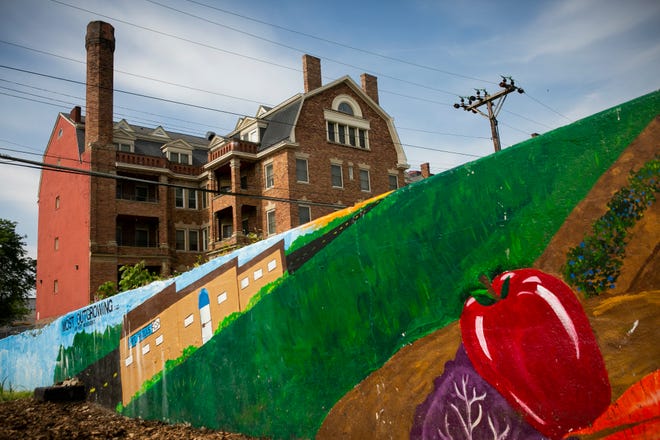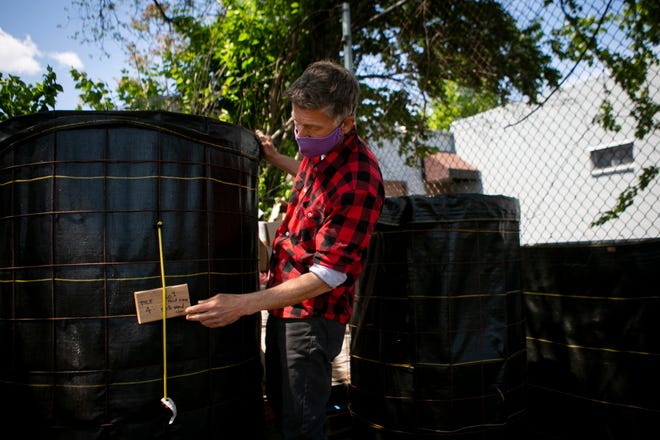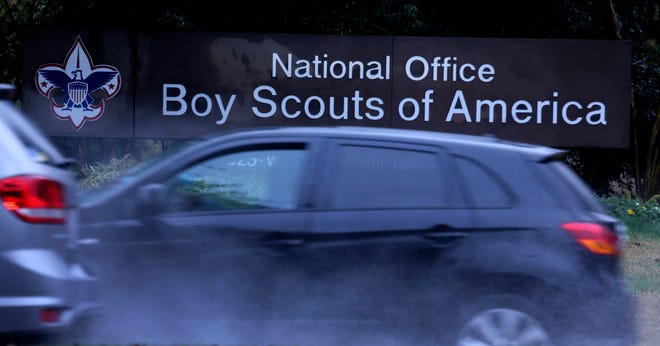Around 2015, Gary Dangel, a 60-year-old graphic designer, settled on what he would do after early retirement. He'd buy two vacant lots near where he lived, lots plagued by rampant littering and illegal activity, and commit himself to rejuvenating the bleak, deserted spots into an oasis.
Six years later, Walnut Hills is looking up. New restaurants and businesses line East McMillan Street. Old buildings are being renovated and new buildings constructed. Arts organizations, like the Cincinnati Ballet and ArtWorks, call Walnut Hills their new home.
But perhaps less noticeable in the neighborhood’s comeback are the eight community gardens scattered around it.
'Everybody has to eat.':Lincoln Heights doesn't have a grocery store with produce. So residents are growing their own food.
Five of these gardens are managed or co-managed by Dangel, who also helps out at the other three gardens when needed. The gardens do what community gardens are designed to do: beautify the immediate area, create volunteer opportunities and produce fresh food for an area that needs it.
But what has amazed Dangel the most is how the gardens have nurtured community.
“We're going from being a diverse community,” Dangel said proudly, “to being a truly integrated community that interacts with one another in a natural way.”

'A beauty to it'
When Dangel bought his first lots in 2015 – one across from Frederick Douglass Elementary School and the other on Melrose Avenue – he was no community gardening expert. But he knew he wanted the gardens to be fertile in every way possible.
“I hadn't been a community activist or community person. I was a corporate, creative person before that. So this was all virgin territory to me,” Dangel said. “I didn't know what would happen.”
He started by removing the loose trash and 6-foot-tall weeds from the lots. With outside help from Lowe’s and some Cincinnati organizations, he brought soil and built beds for the lots.
As neighbors walked by and asked Dangel what he was up to, he invited them to join him. Gradually more and more neighbors began to volunteer.
News:Her NKY neighborhood's urban farm was in danger. So this architect helped come up with a plan
And the freshly minted gardeners were able to get to know each other.
“There was a beauty to it,” said Dangel. “(During) a day of working … people shared things about their life … who we are as people and what's meaningful to us.”
The volunteers were from different races, genders, ages and even financial backgrounds. The gardens were connecting people who previously had not connected before.
“That was the aha moment for me,” said Dangel.
“This was not something that somebody dreamt up as a way to get people that have some differences in culture to come together. This was just something that spontaneously happened because we're out here gardening together.”
'A joy to do'
This sense of community became critical in 2017, when the E. McMillan Street Kroger, the only grocery store in the neighborhood, chose to close its doors.
To reach the nearest grocery store, residents would need a car – something 40 percent of the neighborhood residents lacked. Without easy access to fresh produce, Walnut Hills became, in effect, a food desert.
Community members soon realized they needed to unite to increase food access. They turned to the already working garden network.
After Kroger closed, Dangel was hired by the Walnut Hills Redevelopment Foundation, a nonprofit that works directly with the community to address its issues. He began managing more gardens, including the Taft Garden, and consolidated the other existing neighborhood gardens into a loose organization to address food insecurity more efficiently.
And the gardens then became even more important, more relevant, more binding.
News:Starting a garden this summer? Here are some tips for Midwest beginners
At these gardens, residents grew fresh produce that, over the years, has been donated to organizations like Queen City Kitchen, La Soupe and the Church of the Advent pantry program.
“We're all in this together. This is our world together, this is our community together,” said Anne Zara, who volunteers at the Taft Garden.
“The opportunity to interact and work together to create something to benefit everyone. It's just a joy to do,” she added.
Beyond the joy, you can also see the growth in mutual trust at St. James Art Garden in Eden Park. When Dangel started working there, residents told him he didn't belong there.
Dangel explained that he lived only a block over and that he was there to garden and everyone was welcome to join him in. Still, the neighbors kept their distance.
That is, until last year, when Prince Lang moved to the area, an artist in his twenties, moved to the neighborhood and got involved in the garden space. He then invited his neighbors to join him.
The upshot: St. James has become a garden and a critical social hub, where artists in the community come together on Sunday morning.

Compounding the benefits
This newfound sense of community extends beyond the gardens’ perimeters.
Residents volunteer at events focused on addressing food insecurity, including “Friday Food + Fun,” a weekly event at the former Kroger parking lot where residents can receive free food and personal items.
“(Addressing food insecurity) really has become a team effort,” said Dangel. “That has happened over the course of a few years of just spending a lot of time with one another."
Entertainment:Outdoor movies are back! Where to watch this summer across Greater Cincinnati
Even during the pandemic, the gardens brought people together in the only way they could. Last Thanksgiving, resident Catrice Carpenter utilized the Taft garden to make care packages for elderly residents who would be alone on the holiday. With her son and mother, she picked greens at the garden, complemented this with items from Kroger and delivered them to 10 residents at a neighborhood apartment.
“Seeing that, you know, Kroger is up in Clifton, and a lot of the elderly, especially with COVID, were not able or not 100% confident in going out,” said Carpenter, “the care bags helped out tremendously.”

Margar Breidenbaugh, another resident, started creating care packages for residents with items not covered by SNAP cards after she was furloughed from her job during the pandemic.
Breidenbaugh kept hearing that SNAP cards didn't cover certain items, like feminine hygiene products, and wanted to fill the gap. After asking around for what SNAP users needed, she purchased these items and invited neighbors to help her put together supplies and distribute them safely. (Although Breidenbaugh has gone back to work, The Walnut Hills Redevelopment Foundation continues creating these packages.)
As for the future, the garden volunteers are building out their composting infrastructure in each garden. Food waste is already being converted to compost in the gardens, but the hope is to add more composting methods and increase food waste collection in the neighborhood.
And the result will be doubly beneficial. In the landfill, food waste releases methane, a potent greenhouse gas that contributes to climate change. But at the gardens, the food waste is converted into compost, a soil amendment that helps the produce grow.
It’s all about “how can we take that negative and turn it into a positive,” said Dangel.
That's something that the community now has plenty of experience in.
Source link









